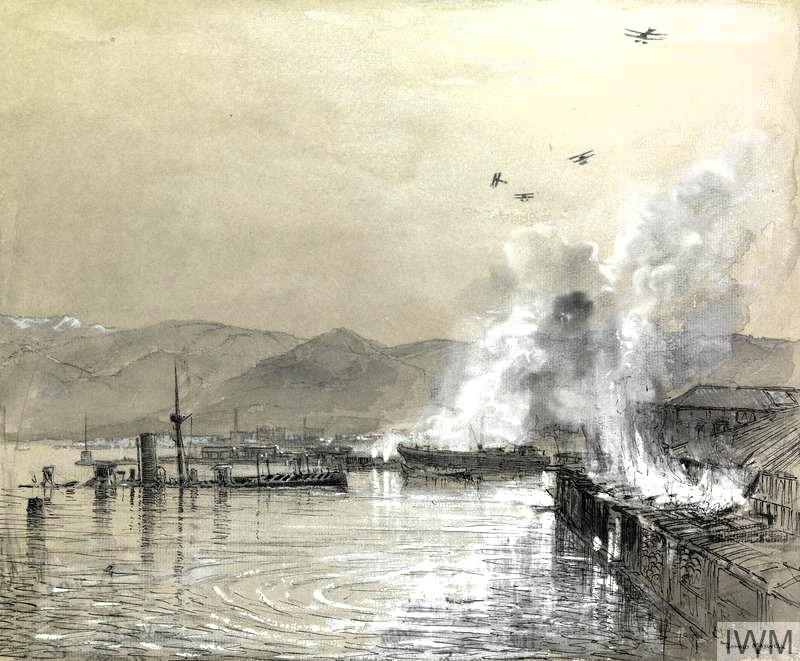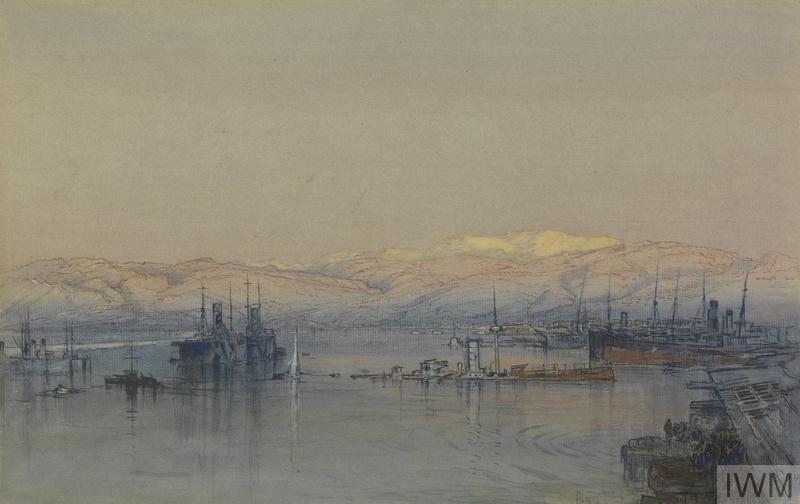During WWI, the Middle East was a battleground for various colonial powers, including the Ottoman Empire, Germany, France, and Britain. The Ottoman Empire, which spanned modern-day Turkey, Iraq, Syria, Lebanon, Jordan, Palestinian Territories, and much of Saudi Arabia, was a major player in the war. The war had a significant impact on Ottoman soldiers, the Middle Eastern home fronts, women's issues, disease/public health, and the development of nationalist narratives in the Arab lands, in Turkey, and among Ottoman minority groups.
Maxwell, Donald
British Drifters in Beyrout Harbour
Watercolour
Height 292 mm, Width 406 mm
Imperial War Museums
In the foreground a few local men stand beside two boats moored at the harbourside, a small wooden hut to the left. Beyond, a line of British drifters are moored along a harbour wall, with a mountain range in the background.
A naval drifter is a boat built along the lines of a commercial fishing drifter but fitted out for naval purposes. The use of naval drifters is paralleled by the use of naval trawlers.
Fishing trawlers were designed to tow heavy trawls, so they were easily adapted to tow minesweepers, with the crew and layout already suited to the task. Drifters were robust boats built, like trawlers, to work in most weather conditions, but designed to deploy and retrieve drift nets. They were generally smaller and slower than trawlers. If requisitioned by navies, they were typically armed with an anti-submarine gun and depth charges and used to maintain and patrol anti-submarine nets.
More on British Drifters
Maxwell, Donald
The Bombing of Beyrout Harbour
Watercolour
Height 279 mm, Width 330 mm
Imperial War Museums
A view of the harbour by night. In the left foreground is a watchtower with mast and flag, while across the harbour is a cityscape of buildings and port installations. A seaplane is approaching from the left, while two others wheel away in the distance. Smoke and flames are seen amongst structures in the harbour.
Maxwell, Donald
Seaplanes Bombing the Customs House, Beyrout
Watercolour
Height 285 mm, Width 342 mm
Imperial War Museums
Four Royal Naval Air Service seaplanes are in the sky in the upper right, having dropped bombs that are exploding in the lower right, damaging wooden buildings. There are ships in the harbour, including one that has partially sunk. Mountains are visible in the background.
Maxwell, Donald
Sunken Tugs in Beyrout Harbour
Watercolour
Height 374 mm, Width 279 mm
Imperial War Museums
A view of Beirut from the water of the harbour, with two sunken tug boats in the right foreground, with little more than their funnels visible above the water. The masts of another vessel are just visible above the water's surface to the left. Just beyond, three local wooden boats are dry-docked on the harbourside, the two to the left supported with wooden struts. Buildings of Beirut are visible behind, including a Mosque with a crescent moon in the night sky just above it.
Maxwell, Donald
Sunset. The Harbour of Beyrout
Watercolour
Height 254 mm, Width 406 mm
Imperial War Museums
A view across Beirut harbour, with a variety of shipping moored within it. To the left is a large dazzle camouflage painted merchant ship, with a partially sunk ship in the centre. To the right an assortment of shipping is moored closely together. Mountains are visible across the horizon.
Maxwell, Donald
ML 248 Entering Tyre
Watercolour
Height 215 mm, Width 336 mm
Imperial War Museums
A view from the deck of a Royal Navy motor launch, with members of the crew standing on deck looking towards the buildings of the city of Tyre in the background.
Maxwell, Donald
ML 206 Entering Tyre
Watercolour
Height 222 mm, Width 342 mm
Imperial War Museums
A Royal Navy motor launch approaches the harbourside at Tyre, shining a bright light at a crowd of local men, who appear to be standing beside piles of supplies. There is a local sailing boat to the left and a line of ships in the distance, in the middle of the composition.
The ML.206 was the second British vessel to enter Tyre after ML.248, during the Palestine campaign
Maxwell, Donald
Motor-launches off Sidon
Watercolour
Height 222 mm, Width 342 mm
Imperial War Museums
Two Royal Navy motor launches sail just off the coast of the walled city of Sidon. The outer walls of the city are sandy-coloured, with white buildings beyond.
Donald Maxwell (1877-1936) was a painter, etcher and illustrator, born in Clapham, south London the son of a Methodist minister. Maxwell studied at Clapham School of Art, the Slade School of Fine Art, and the Royal College of Art all towards the close of the 19th century. After his marriage in 1907, he and his wife resided on a yacht moored on the River Thames before relocating to Rochester, Kent. He soon began writing and illustrating extensively for The Yachting Monthly and other magazines and in 1909, he came to the public's attention with his dramatic sketch, 'The Battle Fleet off Southend', published by the Daily Graphic in 1909. He thereafter embarked on a career as a naval artist and correspondent and became a regular correspondent for the Daily Graphic and the weekly illustrated paper The Graphic continuing to do so until the latter's closure in the 1930's. During World War I was an Official War Artist attached to the Admiralty, visiting Palestine and Mesopotamia. He accompanied the Prince of Wales on his tour of India and illustrated The Prince of Wales' Eastern Book and wrote and illustrated many books on travel and topography and also received poster commissions from Southern Railways. He showed at the Royal Academy, Manchester Academy of Fine Arts and at the Walker Art Gallery, Liverpool. Examples of his work are in the collection of the Imperial War Museum. More on Donald Maxwell
Please visit my other blogs: Art Collector, Mythology, Marine Art, Portrait of a Lady, The Orientalist, Art of the Nude and The Canals of Venice, Middle East Artists, 365 Saints, 365 Days, and Biblical Icons, also visit my Boards on Pinterest
Images are copyright of their respective owners, assignees or others.
Some Images may be subject to copyright
I don't own any of these images - credit is always given when due unless
it is unknown to me. if I post your images without your permission, please tell
me.
I do not sell art, art prints, framed posters or reproductions. Ads are
shown only to compensate the hosting expenses.
If you enjoyed this post, please share with friends and family.
Thank you for visiting my blog and also for liking its posts and pages.
Please note that the content of this post primarily consists of articles
available from Wikipedia or other free sources online.























